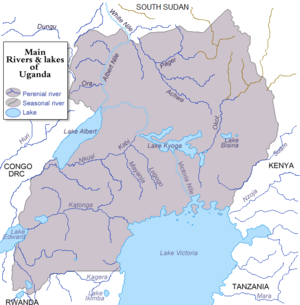Lake Albert (Africa)

Lake Albert, or Albert Nyanza, is a lake in Uganda and the Democratic Republic of the Congo. It is one of the African Great Lakes. Lake Albert is Africa's seventh-largest lake, and the world's twenty-seventh largest lake by volume.
Lake Albert is in the center of Africa. It is the northernmost of the chain of lakes in the "Albertine Rift", the western branch of the East African Rift. The lake is about 160 km (100 mi) long and 30 km (19 mi) wide, with a maximum depth of 51 m (167 ft). It is 619 m (2,031 ft) above sea level.[1]
Lake Albert is part of the complicated system of the upper Nile. Its main sources are from Lake Victoria to the southeast, and from Lake Edward to the southwest. Its outlet, at the northernmost tip of the lake, is the Albert Nile, which becomes the White Nile when it enters South Sudan.
At the southern end of the lake there are swamps. Farther south is the Ruwenzori Range, while a range of hills called the Blue Mountains tower over the northwestern shore
European colonialists operated shipping on the lake. The British planned shipping on Lake Albert as part of a network of railway, river steamer and lake steamer services. The idea was to link British interests in Egypt, east Africa and southern Africa.
References[change | change source]
- ↑ Lake Albert. World Lake Database [1][permanent dead link]
